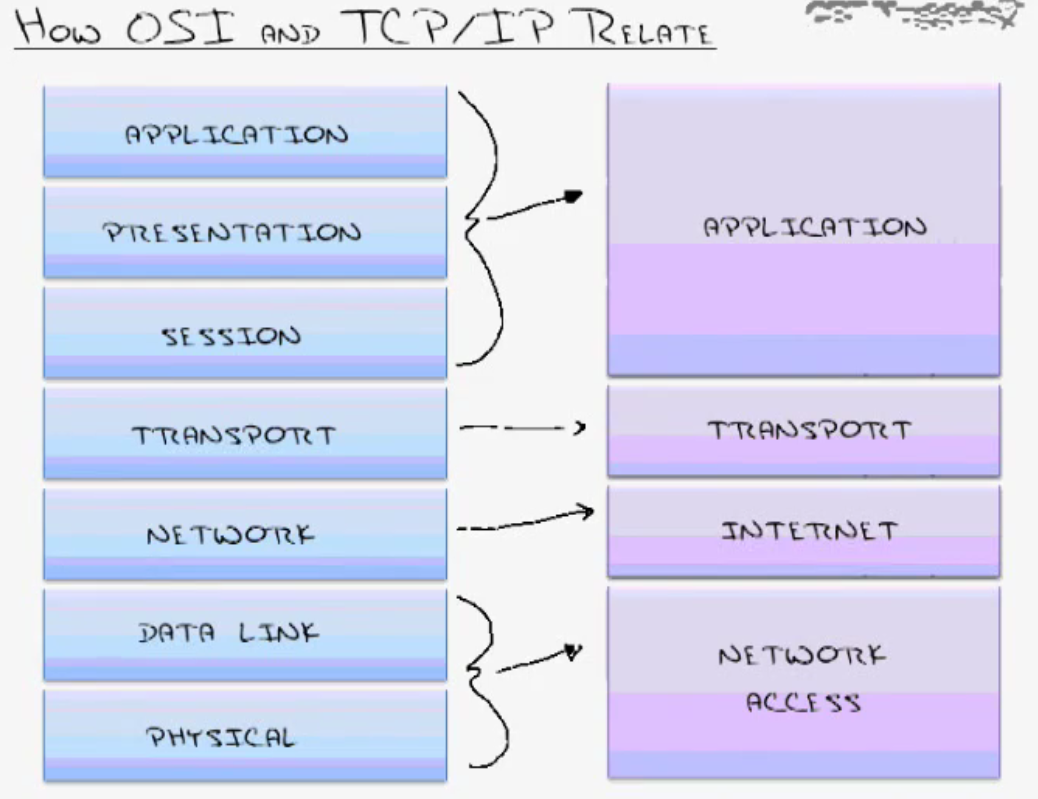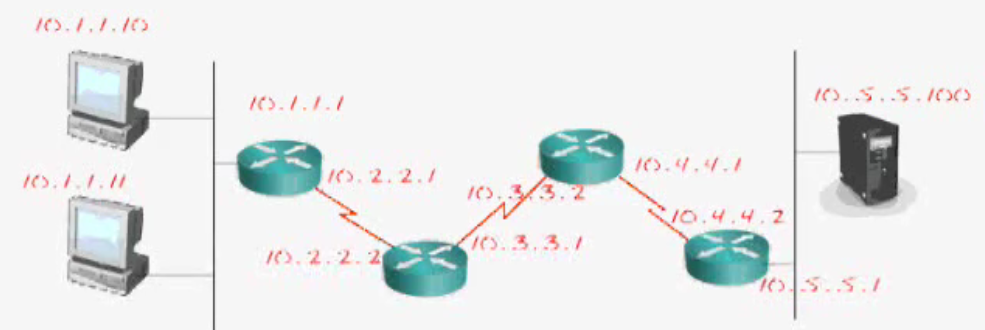How does OSI Model and TCP/IP Relate
- OSI was a competing model with TCP/IP in the 70’s
- It failed because addresses were too complex. Using HEX values and people never thought they would need that many.
- OSI MODEL is used to explain, but TCP/IP is actually in use.
- Actually very similar to new IPv6 Protocols 🙂
- TCP/IP = DOD (Department of Defense)
- TCP/IP is a SUIT of protocols working together
IP Addresses
Consists of 4 numbers (Each called an ‘octet’), ranging from 0-255: Ex. 172.30.5.82
Always combined with a subnet mask and typically a default gateway:
ip: 172.30.5.82
mask: 255.255.255.0
gw: 172.30.5.1
Subnet Mask – 255=Network, 0=Host
As long as network’s match, the hosts can communicate.
One reason to split into different networks is to keep each network from getting so busy it can no longer communicate.
Routers mark a dividing line between networks. No two interfaces of a router ever point to the same network.
Job 1: Routers stop broadcasts
ARP: Address Resolution Protocol. Every computer on the network will receive the call asking for the MAC address for a specific IP.
Computers do not “speak” to IP addresses, but is Layer 2, Data Link, MAC addresses.
For computers to talk, if they are not on the same network (Subnet mask does not match),
Example: 10.1.1.10 wants to send to 10.5.5.100
1. .10 knows the receiving computer is not on it’s network because the network does not match.
2. .10 will ARP for the MAC address of the DEFAULT GATEWAY (DG) which is defined at setup.
3. Armed with the MAC for DG, it builds a packet with
SIP=10.1.1.10
DIP=10.5.5.100
SMAC = MAC for 10.1.1.10
DMAC = MAC for DF
4. Router looks at routing table, and sees the dest. IP Network is not connected, so will send to next router that it thinks “knows the way”, 10.2.2.2
SIP=10.1.1.10
DIP=10.5.5.100
SMAC = MAC for 10.2.2.1
DMAC = MAC for 10.2.2.2
5. Continue until you find router with correct Network, 10.5.5.xxx
Default Address Classes – MEMORIZE!!
Three Usable Classess of Addresses:
127.x.x.x reserved for “loopback”
Class A:
First octet of IP addresses is 1 – 126 (ex: 10.5.1.1, Network = 10, Host = 5.1.1)
Has Subnet Mask 255.0.0.0
16,777,214 Hosts!
Class B:
First Octet of IP Address is 128 – 191 (ex: 150.51.233.1, Network = 150.51, Host = 233.1)
Has Subnet Mask 255.255.0.0
65,536 Hosts
Class C:
First Octet of IP Address is 192 – 223 (ex: 220.1.50.63, Network = 220.1.50, Host = 63)
Has Subnet Mask 255.255.255.0
254 Usable Hosts
Differences between Public and Private Addresses
Public Addresses
- Aquired from ISP
- Usable on the Internet (Public) Networks
- Useable on Internal (Private) Networks
Private Addresses
- Usable on the Internal (Private) Networks ONLY
- These addresses CANNOT communicate directly onto the Internet!! [Achieved via NAT – See Below]
- Three Ranges – MEMORIZE:
- Class A: 10.0.0.0 – 10.255.255.255
- Class B: 172.16.0.0 – 172.31.255.255
- Class C: 192.168.0.0 – 192.168.255.255
- Loopback range used for testing: 127.x.x.x (Only available to itself)
- Auto-Configuration range: 169.254.x.x (If a host cannot get an IP via DHCP and can only communicate on its own local network.)
Basics of NAT (Network Address Translation)
- Purpose is to preserve Public IP Space. Without NAT, we would have ran out of IPs long ago!
- Allows potentially thousands of Private IPs to share a Public IP Address.
- Router gets a PUBLIC IP from ISP.
- All devices in home/business use Private IPs
- As traffic going from the Network to the Internet, the Router “hides” the private IP and replaces it with the Public IP.
Notes:
Cisco recommends not to use more than 500 Hosts per network

